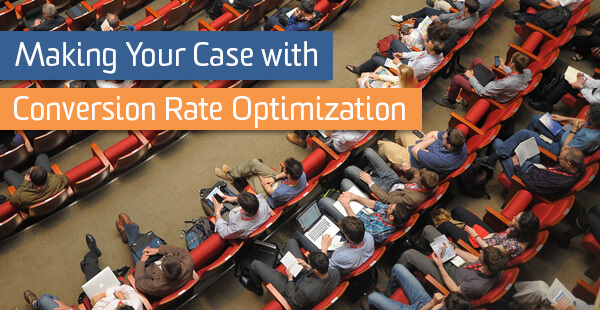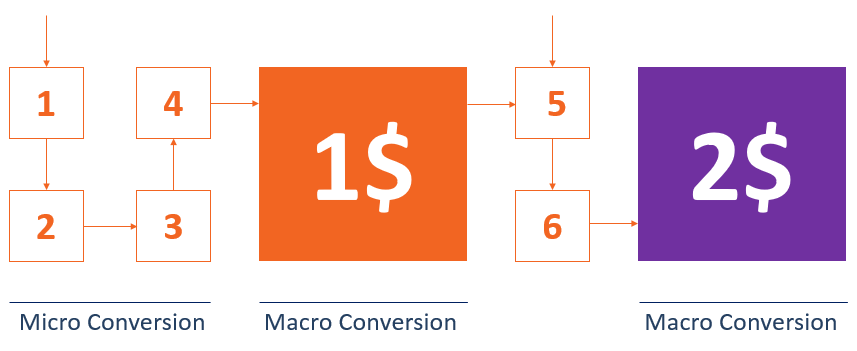Making Your Case With Conversion Rate Optimization

People who know me, know I like to argue points. Good points, bad points, absurd points, it doesn’t matter. If there is an argument to be had, I’ll make my case. Theoretical arguments are the best though. They often lack data and rely heavily on the ability to form a logical thought and speak confidently.
As a marketer, this is a fantastic skill when selling ideas. But if you come up against someone who wields that same power and has more authority than you, then you might find yourself facing a brick wall. How do you make your case to managers, CEOs, and developers who also insist that their ideas are correct without providing a real reason as to why?
Here’s where logic alone won’t cut it. We take our theoretical idea and test it, and we prove with data that our idea was right all long. That’s how.
So, What’s New?
Testing the effectiveness of marketing ideas is nothing new, marketers have been doing it since we first got our hands on direct mail (see Scientific Advertising circa 1923). What has changed is the speed at which we can get results.
Digital channels are giving marketers more data in less time than ever before. That speed allows us to take a question that we’re asked on Monday and answer it with data on Friday. But data is only one piece of the puzzle. Data needs to support your reason. Without well-defined goals and clear direction you can end up in a battle of wills that causes you to make little progress for your company.
Here is how you can align your testing ideas with your business objectives and rationalize them it with data.
Know Your Goals
Before you get started you’ll need to understand your goal. Having a clear reason for testing something sets you up for all future successes. It should be expressed in two ways, belief and the bottom line. You can use both to frame your arguments for better buy-in.
Why as in Core Beliefs
People don’t buy what you do, they buy why you do it. That doesn’t just apply to your customers, it applies to your internal team as well. When you can frame your idea by tying it back to the core value of the company, it changes how people view the idea.
Simon Sinek wrote an entire book about why this is so important. You don’t have to read the book, his TED talk has everything you need to know. In his book, Simon uses Apple as one of his main examples. Here is the difference between pitching your idea by starting with what it is vs starting with why you do it.
Starting with what: “We make great computers, they’re beautifully designed, simple to use, and user friendly. Want to buy one?”
Starting with why: “Everything we do, we believe in challenging the status quo. We believe in thinking differently. The way we challenge the status quo is by making our products beautifully designed, simple to use, and user friendly. We just happen to make great computers. Want to buy one?”
Some companies might not have this type of why well defined, but you should have at least a vague idea about what motivates the people in your company. How does your test idea align with the company’s core beliefs? Does your idea align at all, or is it just something you read in an article this weekend and would like to test?
Knowing why can also save you a lot of time by allowing you to avoid testing things that might never have worked. All too often we get a request like “We want to test the layout of X” or “we want to change a call to action for Z”. And my immediate reaction is always: “That’s great! But why?”. To which I usually get silence or a response like “Well, we just think changing it might lead to greater website conversations.” That’s a classic what before why response.
Companies that put why first would respond with something like this: “Well, we believe in thinking differently. Recently we’ve been noticing a trend towards a certain type of call to action in our industry and we want to see how doing the opposite of that would effect our conversion rate.” You can see how that type of response has a reason rooted in the core beliefs of the company.
Why as in The Bottom Line
What you test should always be working to improve your bottom line. Whether you’re testing a micro or macro conversion, you need to make sure it is clear how the experiment could potentially improve the companies revenue.

Macro conversions are easy to identify. They are end of funnel and are likely to already be set up as goals in your Google Analytics account. Macro conversions usually take the form of a product purchase, contact completion, phone call, etc.
Identifying micro conversion and drawing clear causation to the bottom line might be more difficult. For an eCommerce website micro conversions are simple. They would include clear actions like add to cart, size/color selection, or viewing product images. But for a publisher, micro conversions could include both passive actions (avg. time on page, pages/session, scroll depth, etc.) and active actions (social shares, video plays, engaging with an HTML data visualization, etc).
The challenge with micro conversions is that understanding how they affect the bottom line is not always clear. In order to make a strong case for testing micro conversions, you’ll need to lean on your company’s core beliefs to frame how testing micro conversions relates to the company’s beliefs and bottom line.
Who You Test is Just as Important as What You Test
It leads to better test ideas. Because testing places an emphasis on data, it can be easy to think about everything on your site (including people) as a data point. To avoid this, approach testing by keeping your company’s core beliefs in mind and you’ll be more successful in coming up with ideas that focus on helping people, not improving numbers.
It ensures you have clean data. If you understand why you’re going to run a test, then you can use targeting to ensure that the right people see the experiment. Having a solid sample is key to when arguing your point. If there is an obvious shadow cast on your experiment data, say perhaps you forgot to exclude internal traffic, then you will undermine your argument. Targeting is an essential part of testing and should not be overlooked. If you set your experiments up correctly, who you test will become a weighted addition to your case.
Communicate Results with Everyone
Hopefully your experiment results speak for themselves. Whether your theory is right or wrong, be sure to publicize the results and vocalize the additional ideas that you would like to test. Articulate how the results of an experiment would impact the company, how what you learned is or is not reflected in the company’s core values, and how other departments might use what you learned to improve other consumer touch points (sales, customer service, advertising, etc.).
Do this and what you’ll end up with is an idea that is supported by data and intersects your company’s core values, goals, and customer base.


